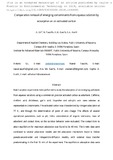Mostrar el registro sencillo del ítem
Comparative removal of emerging contaminants from aqueous solution by adsorption on an activated carbon
| dc.creator | Gil Bravo, Antonio | es_ES |
| dc.creator | Taoufik, Nawal | es_ES |
| dc.creator | García Mora, Ana María | es_ES |
| dc.creator | Korili, Sophia A. | es_ES |
| dc.date.accessioned | 2020-04-15T11:15:33Z | |
| dc.date.available | 2020-04-15T11:15:33Z | |
| dc.date.issued | 2019 | |
| dc.identifier.citation | A. Gil, N. Taoufik, A. M. García & S. A. Korili (2019) Comparative removal of emerging contaminants from aqueous solution by adsorption on an activated carbon, Environmental Technology, 40:23, 3017-3030, DOI: 10.1080/09593330.2018.1464066 | en |
| dc.identifier.issn | 0959-3330 | |
| dc.identifier.uri | https://hdl.handle.net/2454/36722 | |
| dc.description.abstract | Batch sorption experiments were performed to study the adsorption of six emerging pollutants from aqueous solutions using a commercial granular activated carbon as adsorbent. Caffeine, clofibric acid, diclofenac, gallic acid, ibuprofen and salicylic acid were selected as representative contaminants. The activated carbon was characterized by nitrogen adsorption at 77 K, and through the determination of point of zero charge. The effects of several operational parameters, such as pH, initial concentration of organic molecules, mass of adsorbent and contact time, on the sorption behaviour were evaluated. The contact time to attain equilibrium for maximum adsorption was found to be 40 min. The kinetic data were correlated to several adsorption models, and the adsorption mechanism found to follow pseudo-second-order and intraparticle-diffusion models with external mass transfer predominating in the first 15 min of the experiment. The equilibrium adsorption data were analysed using the Freundlich, Langmuir and Toth isotherm equation models. The similar chemical structure and molecular weight of the organic pollutants studied to make the adsorption capacity of the activated carbon used very similar for all the molecules. | en |
| dc.description.sponsorship | This work was supported by the Spanish Ministry of Science and Innovation (MICINN) through project MAT2013-47811-C2-1-R. | en |
| dc.format.extent | 40 p. | |
| dc.format.mimetype | application/pdf | en |
| dc.language.iso | eng | en |
| dc.publisher | Taylor & Francis | en |
| dc.relation.ispartof | Environmental Technology, 2019, 40 (23), 3017-3030 | en |
| dc.subject | Adsorption | en |
| dc.subject | Activated carbon | en |
| dc.subject | Emerging water pollutants | en |
| dc.subject | Pharmaceutical pollutants | en |
| dc.title | Comparative removal of emerging contaminants from aqueous solution by adsorption on an activated carbon | en |
| dc.type | info:eu-repo/semantics/article | en |
| dc.type | Artículo / Artikulua | es |
| dc.contributor.department | Ciencias | es_ES |
| dc.contributor.department | Zientziak | eu |
| dc.contributor.department | Institute for Advanced Materials and Mathematics - INAMAT2 | es_ES |
| dc.rights.accessRights | info:eu-repo/semantics/openAccess | en |
| dc.rights.accessRights | Acceso abierto / Sarbide irekia | es |
| dc.identifier.doi | 10.1080/09593330.2018.1464066 | |
| dc.relation.projectID | info:eu-repo/grantAgreement/MINECO//MAT2013-47811-C2-1-R/ES/ | en |
| dc.relation.publisherversion | https://doi.org/10.1080/09593330.2018.1464066 | |
| dc.type.version | info:eu-repo/semantics/acceptedVersion | en |
| dc.type.version | Versión aceptada / Onetsi den bertsioa | es |


